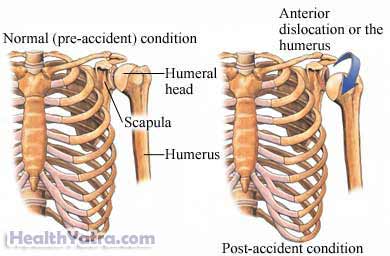Definition
A shoulder dislocation occurs when the head of the humerus (upper arm bone) pops out of the shallow shoulder socket of the scapula (called the glenoid). This can happen when a strong force pulls the shoulder upward or outward, or from an extreme external rotation of the humerus.
Glenohumeral dislocations are generally classified by the direction of dislocation of the humerus.
Dislocation can be full or partial:
- Partial dislocation (also called subluxation)—the head of the humerus slips out of the socket momentarily and then snaps back into place
- Full dislocation—the head of the humerus comes completely out of the socket
Shoulder dislocations can also be associated with fractures—one can have a fracture and dislocation at the same time. Nerves and blood vessels can sometimes be injured with a severe shoulder dislocation, requiring immediate medical attention.

Causes
Shoulder dislocation can be caused by:
- Falling on an outstretched arm
- A direct blow to the shoulder area, such as in automobile accident
- Forceful throwing, lifting, or hitting
- Force applied to an outstretched arm, such as in a football tackle
Risk Factors
A risk factor is something that increases your chance of getting a disease, condition, or injury.
Risk factors for a shoulder dislocation include:
- Previous shoulder dislocation or subluxation
- Participating in contact sports such as football, wrestling, and hockey
- Conditions involving loose joints, such as Ehlers-Danlos syndrome
- Poor muscle tone
Symptoms
Symptoms include:
- Pain, often severe
- Instability and weakness in the shoulder area
- Inability to move the shoulder
- Swelling
- Bruising
- Shoulder contour appears abnormal
- Numbness and tingling around the shoulder or in the arm or fingers
Diagnosis
The doctor will ask about your symptoms and how the injury occurred, and will examine the injured area. Diagnosis is also based on the physical exam of your shoulder area. The doctor may do an x-ray to rule out a related fracture or damaged surrounding soft tissue and to see which direction the shoulder is dislocated.
Treatment
Do not try to force the bones back into place. Seek medical care immediately. Delaying treatment increases the chance of permanent damage to the shoulder joint.
Treatment includes:
- Closed reduction —The doctor will move the head of the humerus back into the shoulder joint socket by applying traction to your arm. You will be given pain medication before this procedure begins.
- Immobilization —After the reduction, you will need to wear a sling or a device called a shoulder immobilizer to keep the shoulder from moving. The shoulder is generally immobilized for about four weeks, and full recovery takes several months.
- Rest —It is important to rest your shoulder and not put any strain on the joint area.
- Ice and heat —Apply ice or a cold pack to your shoulder for 15-20 minutes, four times a day, for the first two days. After the third day, use a heating pad for 20 minutes or less might help relief muscle soreness. This helps reduce pain and swelling as well. Wrap the ice or cold pack in a towel. Do not apply the ice directly to your skin.
- Rehabilitation exercises —After removal of the shoulder sling, begin exercises to restore strength and range of motion in your shoulder as recommended by your healthcare professional.
- Pain medications —Nonsteroidal anti-inflammatory drugs (NSAIDs) or acetaminophen (Tylenol) help relieve pain.
- Surgery —Surgery is rarely needed for a first time dislocation. It is often needed for a shoulder that dislocates repeatedly.
If you are diagnosed with a dislocated shoulder, follow your doctor’s instructions .
Prevention
To help prevent a shoulder dislocation:
- Do exercises to strengthen the muscles around your shoulder.
- Wear proper safety equipment and padding for protection in sports.
- Avoid falls.
